
 |
The combined analysis of valence photoelectron spectra and diffraction patterns |
![]()
|
ALS Workshop on Theory and Computation for Synchrotron Applications
Traditional photoemissionAs sketched in Fig. 1 several branches of photoemission spectroscopy in the vacuum ultraviolet (VUV) regime have developed and are still extending. There is a long history in quick and easy methods for the interpretation of photoemission spectra all of which are more or less approximations to the most accurate one-step model. The latter has been designed as a computer code during the 1970s by Pendry and since then has experienced many extensions, e.g. the application to non-muffin-tin potentials or to relativistic systems. The most direct access uses as a shortcut to the one-step model the identification of an angle integrated photoemission spectrum with the density of states (DOS). The DOS still is a valuable tool in the case of complicated systems where high quality surfaces cannot be prepared.
Fig. 1: Traditional and modern aspects of photoemission in the vacuum ultraviolet.
Fig. 2: Accuracy of band mapping methods. Upper part: Valence (dotted) and conduction (solid) bands, the latter being shifted by the photon energy to lower energies; the bars denote the amplitudes the band enters the final state wavefunction. Lower part: Photoemission spectrum calculated from the above bandstructure; the bars are obtained in "theory" by marking all intersections of the valence bands with the conduction bands (direct transitions), in "experiment" by standard experimental deconvolution techniques of the theoretical spectrum.
|
|
In the following, both last blocks in Fig. 1 characterizing some trends in the modern development of VUV-spectroscopy are discussed in turn.
Photoemission towards many-body effectsFig. 4 displays some many-body effects currently under discussion for changing the photocurrent beyond the one-step model. It is represented by the photoemission vertex which symbolically decribes the golden rule formula if the corrections like the wavy and broken lines are omitted. The three lines of the triangle denote Green's functions that of the vertical line being attributed by its imaginary part to both initial states in the squared matrix element together with the energy delta function. The remaining lines denote the state of the escaping electron and its complex conjugate, resp., being excited by the light at the points where the wavy line enters the vertex. |
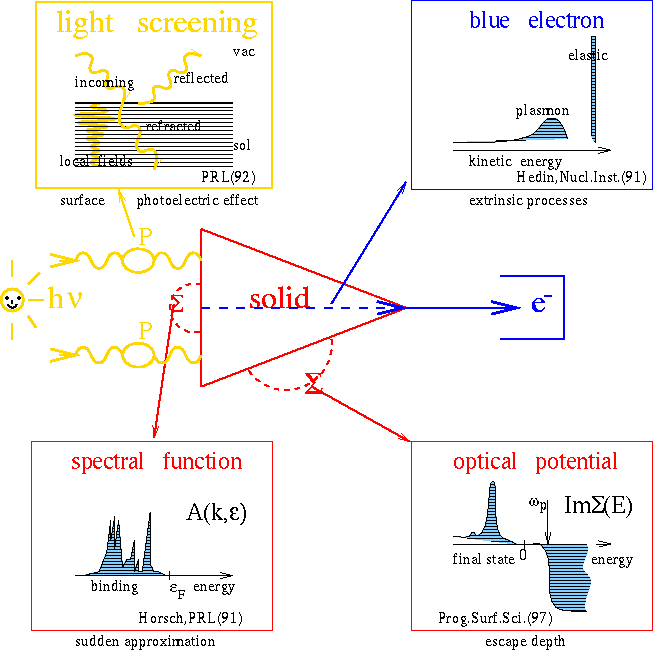 Fig. 4: Photoemission towards many-body effects. Several many-body effects contributing to the photocurrent schematically drawn as corrections to the photoemission vertex, middle part; upper left: the exciting photon is deteriorated by surface and bulk induced response fields; upper right: inelastic effects like plasmon excitations add to the elastic part of extrinsic final state scattering; lower left: the final state structure is completely neglected in the sudden approximation, but the small energy scale of superconductivity features may justify the solely use of an initial state spectral function; lower right: the selfenergy determines the complete quasiparticle corrections, especially the hole life time and the final state optical potential. |
|
Regarding the initial state a selfenergy correction can be introduced accounted for by using the many-body spectral density instead of the imaginary part of the bare, i.e. unperturbed solution of the one-particle Schrödinger equation. Neglecting all kinds of final state scattering the spectral function often is taken to represent the photocurrent, which is denoted as the "sudden" approximation. Frequently applied to superconductivity spectra it is claimed to be justified by the tiny energy scale superconductivity deals with.2 However, the neglected many-body effects might play on the same stage. Similarly, magnetic exchange can be considered in terms of the spectral function and a lot of investigations about spin dependent photoemission use this representation in a relativistic formulation, e.g. to investigate the magnetic bandstructure via magnetic linear dichroism.3 The bubbles introduced into the wavy lines represent the screening of the incident light by the solid and especially by its surface. The solid response is determined by calculating the full momentum and energy dependent dielectric function and inserting the polarization diagram. The surface response is connected with the so called surface photoelectric effect.4 Specifically sensitive to both are layered crystals, because their anisotropic structure allows to separate these effects which predominantly affect those states dispersing in surface perpendicular direction.5,6 Furthermore, large induced local fields arise near the plasma frequency in these materials.7 The selfenergy insertion into the final state Green's function is another representation for the optical potential. Its imaginary part stands for a rough collection of the losses the escaping electron suffers and is also described by the escape depth culminating in a vastly exploited empirical relation between that depth and the kinetic energy. A first ab-initio calculation8 in the GW-approximation of the self-energy is displayed in Fig. 5 and shows the typical behavior of the empirical formula with respect to the quadratic behavior near the Fermi energy and the strong increase near the plasmon threshold. The same figure also shows how strongly the photoemission spectra are affected by the self-energy insertions into both the initial and final states. With respect to high resolution spectroscopy these changes can hardly be tolerated. |
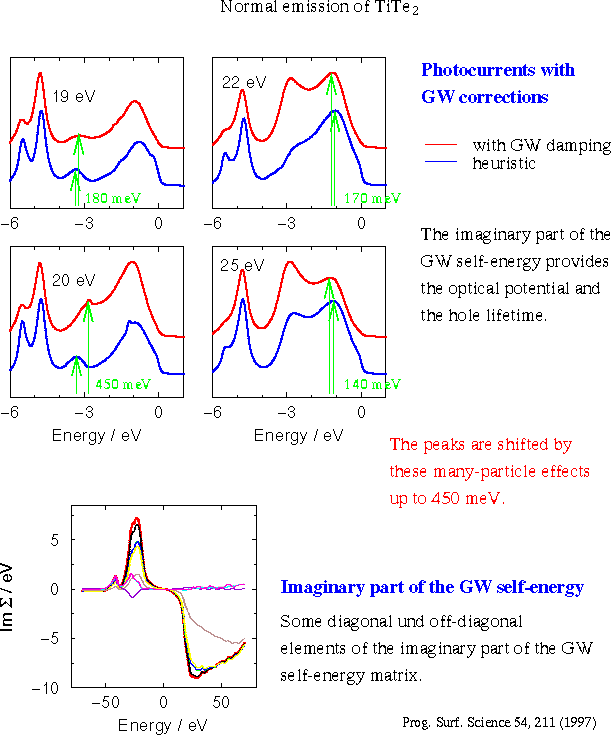 Fig. 5: Ab-initio calculated selfenergy and its effect on the spectra; compared is with spectra whose hole life time and optical potential are adjusted to empirical constants frequently used in photoemission. |
|
A further correction is sketched in Fig. 4 which actually mostly regards core level spectroscopy and which will be discussed at some other place of this workshop. The plasmon satellites surely will also influence the valence band spectra, however, to date it is completely unknown in what manner. The blue electron approach of Hedin9 insufficiently represented by the broken line dividing the vertex into two shows how intrinsic and extrinsic losses mix and make the sudden approximation rather valueless. This and the whole zoo of mentioned and unmentioned many-body effects need photoemission investigations as their prominent investigative tool. For future research they are regarded less as spoiling the traditional photoemission investigation but rather as representing extremely interesting objects. The current development towards highest resolution opens the door to these challenges.
Full hemisphereThe last topic discussed here deals with the strongly increasing representation of photoemission results in two-dimensional patterns with respect to the surface parallel momentum space, partly as a collection of angular scans and partly as an instantaneous full hemisphere mapping of the photocurrent. The latter experienced an important impact by the development of suitable detectors.10,11 In Fig. 6 some topics dicussed in this context are listed.
|
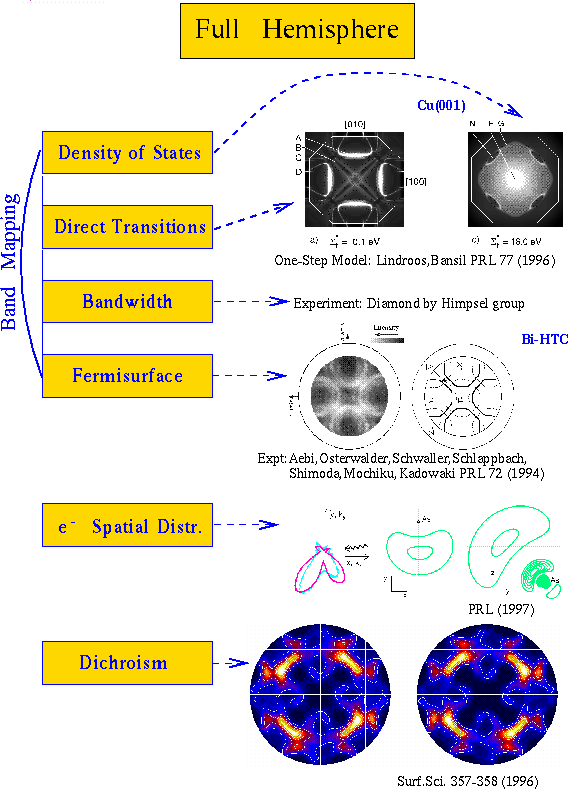 Fig. 6: Some topics being discussed in connection with full hemisphere photocurrent acceptance: By varying the escape depth (selfenergy) the structure changes from a DOS like shape to direct transitions; visualization of the Fermi surface for a high temperature superconductor; identification of the emitting charge density of the dangling bond for the GaAs(110) surface; change of the emission pattern with polarization of the circularly polarized light. |
|
For example, a specific procedure for determining the bandwidth is sketched in Fig. 7. This quantity is actually in discussion because of quasiparticle effects. Here, definite energetic configurations in momentum space are exploited with the help of two-dimensional representations. Generally, one of the aims is to directly visualize the bands and the surface DOS. At fixed energies of initial and final state the patterns show a lot of similarities with these quantities. However, for the reason stated above, they need the full calculation to yield a reliable interpretation. The patterns show different shapes in different Brillouin zones, they depend on the damping of the final state, and the lack or presence of emissions cannot be determined in advance.
|
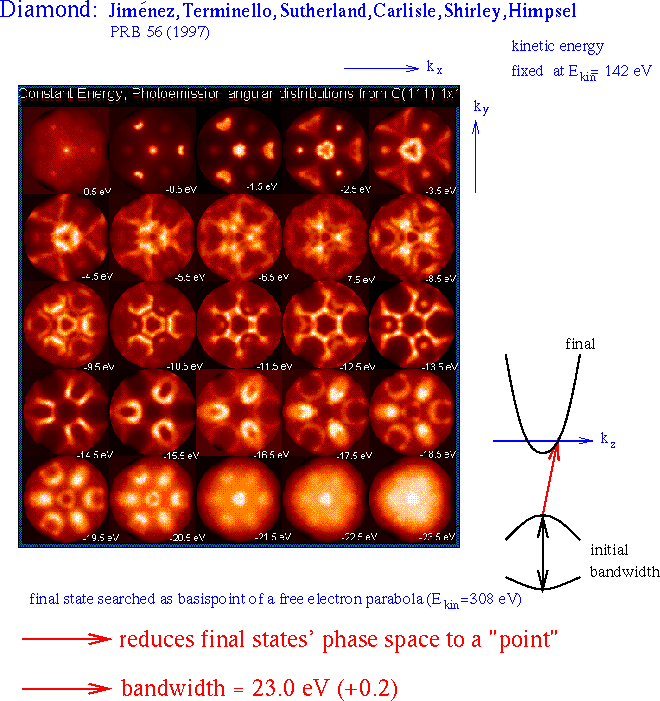 Fig. 7: Determination of the bandwidth by confining the phototransition to the band edges of the valence and conduction bands. |
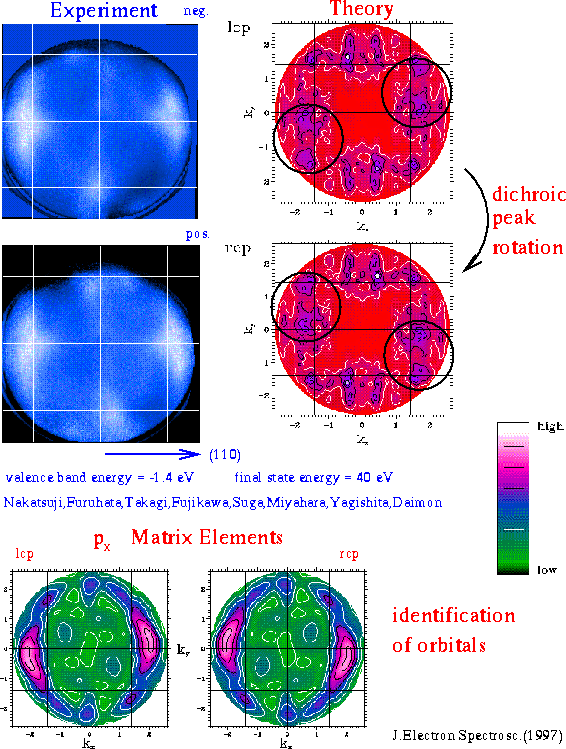 Fig. 10: Circular dichroism for the valence bands of Si(001);the encircled high intensity parts rotate similarly to experiment for going from left to right hand circularly polarized light; the origin of these emissions is traced by considering the matrix elements to px orbitals; the emissions near kx=0 rotating oppositely to experiment are associated with py orbitals of the surface below (above) bonds in theory (experiment). |
ConclusionsIn conclusion probing many-body effects as well as imaging the wave function can be seen as most promising developments of valence band photoemission. The interface between experiment and theory, see Fig. 11, shows many connections, however, the actual state of the art demands full theoretical calculations for the interpretation as it is practised in the analysis of low energy electron diffraction (LEED) and XPD data. To ask only for a quick and easy interpretation of photoemission looks similar to relying entirely on imaging the optical LEED without analysis of I(V) curves or on using exclusively forward and backward scattering for the XPD analysis.
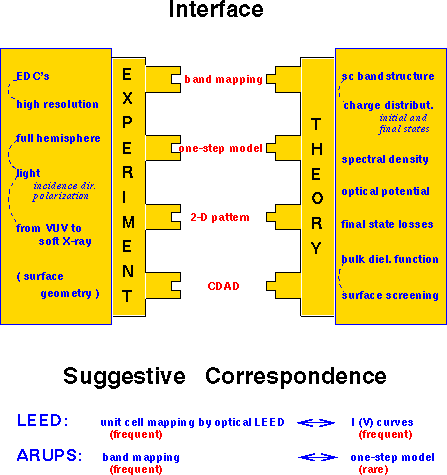 Fig. 11: Sorry for listing only 4 pins of the interface connector
|
Wolfgang Schattke
![]()
 |